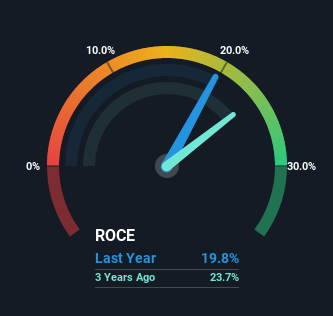Balrampur Chini Mills (NSE:BALRAMCHIN) Might Be Having Difficulty Using Its Capital Effectively

What trends should we look for it we want to identify stocks that can multiply in value over the long term? One common approach is to try and find a company with returns on capital employed (ROCE) that are increasing, in conjunction with a growing amount of capital employed. If you see this, it typically means it's a company with a great business model and plenty of profitable reinvestment opportunities. So when we looked at Balrampur Chini Mills (NSE:BALRAMCHIN), they do have a high ROCE, but we weren't exactly elated from how returns are trending.
Understanding Return On Capital Employed (ROCE)
For those who don't know, ROCE is a measure of a company's yearly pre-tax profit (its return), relative to the capital employed in the business. The formula for this calculation on Balrampur Chini Mills is:
Return on Capital Employed = Earnings Before Interest and Tax (EBIT) ÷ (Total Assets - Current Liabilities)
0.20 = ₹5.9b ÷ (₹45b - ₹15b) (Based on the trailing twelve months to March 2022).
So, Balrampur Chini Mills has an ROCE of 20%. In absolute terms that's a great return and it's even better than the Food industry average of 12%.
View our latest analysis for Balrampur Chini Mills

Historical performance is a great place to start when researching a stock so above you can see the gauge for Balrampur Chini Mills' ROCE against it's prior returns. If you want to delve into the historical earnings, revenue and cash flow of Balrampur Chini Mills, check out these free graphs here.
How Are Returns Trending?
When we looked at the ROCE trend at Balrampur Chini Mills, we didn't gain much confidence. Historically returns on capital were even higher at 43%, but they have dropped over the last five years. On the other hand, the company has been employing more capital without a corresponding improvement in sales in the last year, which could suggest these investments are longer term plays. It may take some time before the company starts to see any change in earnings from these investments.
On a side note, Balrampur Chini Mills has done well to pay down its current liabilities to 33% of total assets. So we could link some of this to the decrease in ROCE. What's more, this can reduce some aspects of risk to the business because now the company's suppliers or short-term creditors are funding less of its operations. Since the business is basically funding more of its operations with it's own money, you could argue this has made the business less efficient at generating ROCE.
The Key Takeaway
To conclude, we've found that Balrampur Chini Mills is reinvesting in the business, but returns have been falling. Yet to long term shareholders the stock has gifted them an incredible 154% return in the last five years, so the market appears to be rosy about its future. However, unless these underlying trends turn more positive, we wouldn't get our hopes up too high.
Since virtually every company faces some risks, it's worth knowing what they are, and we've spotted 3 warning signs for Balrampur Chini Mills (of which 1 is a bit unpleasant!) that you should know about.
High returns are a key ingredient to strong performance, so check out our free list ofstocks earning high returns on equity with solid balance sheets.
Valuation is complex, but we're here to simplify it.
Discover if Balrampur Chini Mills might be undervalued or overvalued with our detailed analysis, featuring fair value estimates, potential risks, dividends, insider trades, and its financial condition.
Access Free AnalysisHave feedback on this article? Concerned about the content? Get in touch with us directly. Alternatively, email editorial-team (at) simplywallst.com.
This article by Simply Wall St is general in nature. We provide commentary based on historical data and analyst forecasts only using an unbiased methodology and our articles are not intended to be financial advice. It does not constitute a recommendation to buy or sell any stock, and does not take account of your objectives, or your financial situation. We aim to bring you long-term focused analysis driven by fundamental data. Note that our analysis may not factor in the latest price-sensitive company announcements or qualitative material. Simply Wall St has no position in any stocks mentioned.
About NSEI:BALRAMCHIN
Balrampur Chini Mills
Engages in the manufacture and sale of sugar in India.
Reasonable growth potential and fair value.
Market Insights
Community Narratives



